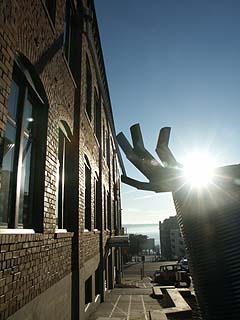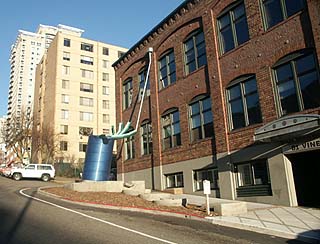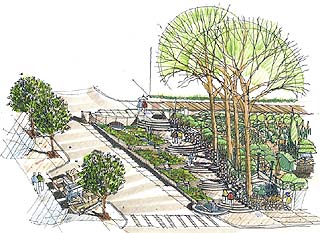|
Subscribe / Renew |
|
|
Contact Us |
|
| ► Subscribe to our Free Weekly Newsletter | |
| home | Welcome, sign in or click here to subscribe. | login |
Architecture & Engineering
| |

|
|
Design Perspectives By Clair Enlow |
February 19, 2003
A watershed moment on a Belltown street
Design Perspectives
Don’t play in the street. That’s the message of traffic engineers and city officials trying to keep the roadway clear for traffic and storm water flowing to treatment plants.

Photos by Carolyn Geise Buster Simpson’s “Beckoning Cistern” reaches out, as if to touch the city. |
But things are getting a little out of hand at Western and Vine. "Beckoning Cistern," the newest addition to the Growing Vine Street neighborhood plan in Belltown, is like a smart, cheeky teenager who has bent the rules.
A large cylinder made of corrugated metal has been mounted at a tilt beside the sidewalk next to 81 Vine, a renovated brick building. The Windex- blue cylinder leans toward the building, and out of this "sleeve," five green gutter-like "fingers" reach upward toward the roof terrace of the condominium building. A rain gutter from the edge of the roof leaves the wall of the building to meet the index finger of "Beckoning Cistern."
Sculpture meets infrastructure on Vine Street. The spirit of the sculpture, created by artist Buster Simpson, lies somewhere between an indirect reference to Belltown’s industrial roots and a three-dimensional cartoon. Simpson, with ironic relish, likes to compare it to the fingers of Adam reaching out to touch the hand of God in the Sistine Chapel ceiling. Indeed, the cistern finger looks like it is making an urgent but tenuous connection.
And it is. Capturing and using roof storm water, instead of feeding it into the nexus of drains and sewers that lead to water treatment plants, is one of several very good ideas that is so novel it is difficult to permit. And when the captured water is used to serve planting beds and other planned landscape elements in city right-of-way, it gets even more tenuous.
Getting projects like "Beckoning Cistern" and the green strip at its base permitted has been slow. But the Growing Vine Street project continues to break new ground, challenging the notions of what a city street can be -- and proving that it is possible to do something better, step by step.

The sculpture captures and uses roof storm water, on plant beds and other planned landscape elements in the city right-of-way. |
First there was 81 Vine itself, a building renovated by Growing Vine Street's founder and tireless promoter Carolyn Geise, the architect and developer of the building. With a one-story addition atop the three-story historic cannery, 81 Vine has a rooftop terrace that supports its own green biofiltration system for roof water. A large, branching downspout in the middle of the wall on Vine, also created by Buster Simpson, serves notice to passers-by that there is something very different going on with the infrastructure here.
"Beckoning Cistern" confirms that suspicion. When it comes to storm water and drainage, the cistern and the planting strip on which it is installed make it very hard to draw the line between work and play. It is the first in a series of water cachement elements along the two-block section of Vine street, beginning with the green strip designed by Geise Architects with landscape architect Peggy Gaynor.
The water in the cistern begins on the rooftop of 81 Vine, where it is gathered into a downspout at the edge of the renovated three-story building. After a short vertical drop at the edge of the roof, the pipe cants toward the street, taking the water away from the building and out to the reaching index finger of the "Beckoning Cistern."
A small trickle of the water coming from the down spout into the cistern is channeled off to the "thumb," which points toward Elliott Bay. From the end of that digit, it falls into a "circular wetland," a round concrete planter to be filled with boggy growth. Two more of these planters cascade down the slope beside the sidewalk, further filtering water as it supports the plants within.

Rendering by Carlson Architects The Cistern Steps will be an important step in making Vine Street an urban watershed. The project, now awaiting final funding, was designed by Carlson Architects and Greg Waddell, artist Buster Simpson, landscape architect Peggy Gaynor and SvR Engineering. In addition to support from the city’s Department of Neighborhoods, funding for the $500,000 project comes from a King County Waterworks grant, the Committee of 33, Intracorp and Geise Architects. |
In the wet months, the 10-foot high, 6-foot-diameter cistern will stay full enough that the owners of the condominiums at 81 Vine and their neighbors can turn on the spigot and get ample water for the plants on their terraces and in their units. But in the heat of summer they will have to go back to the city water system to keep their plants alive.
It’s not much of a net gain for the city water supply. But it shows that is it possible to make a street of high rises into a neighborhood, one with a truly urban front yard.
The plan for Growing Vine Street is just like it sounds -- a plan for greening the entire length of Vine Street, from Elliott Bay to Westlake. The idea began in 1995 with the P-Patch at Vine and Elliott, a welcoming neighborhood garden spot with an artful, gated entry at the corner.
As local artists and residents met and dreamed, the idea of making more of the public domain more neighborly took root. With the support of the Department of Neighborhoods, three cottages near the P-Patch that date from the earliest days of Belltown have been renovated to house an artist-in-residence program.
"Now there are hundreds of people involved, and many more who want to get involved," said Geise.
One of the most anticipated parts of the Growing Vine Street vision is the Cistern Steps, a terraced walkway and watercourse on the steeply inclined block of Vine Street between Western and Elliott avenues.
The steps will extend the P-Patch environment into a new pedestrian amenity beginning at the alley. They step down in arcing sets of terraces, with slow, stately risers. Water gathered from surrounding roof tops will step down beside them in a series of pools surrounded by sedges and other plantings.
At first, the water will come from the rooftop of 81 Vine through "Beckoning Cistern," and from specially designed and dedicated drainage from the newly constructed Vine Building across the street. At the top, some will be diverted to the P-Patch, where a friendly, old fashioned farm pump will make the water available. The rest drops through the series of pools, eventually reaching one at the corner that is literally jewel-like, a perfectly rounded basin of rock-hewn jade.
| Growing Vine Street team |
|
Design for “Beckoning Cistern,” its base and green space was provided by artist Buster Simpson, Geise Architects, landscape architect Peggy Gaynor, civil engineer SvR Design Company, structural engineer Thomas Hammond, and special engineer for cistern Swenson Say Faget. Kruse Brothers Construction was the general contractor. "Beckoning Cistern" was fabricated by Fabrication Specialties. Major support came from Seattle Public Utilities Percent for Arts Fund, Seattle Office of Arts and Cultural Affairs and 81 Vine, developers of the 81 Vine Building. The rest came from a Department of Neighborhoods small and simple grant, the Committee of 33 and neighborhood residents.
“Beckoning Cistern” is one of the elements of Growing Vine Street, a master plan developed under the leadership of Carlson Architects. |
From the lowest point, overflow will go into the storm water system. But eventually, said Geise, all of the rooftop drainage along the length of Vine Street could go into Elliott Bay as clean, filtered water. Then the street would truly be a watershed.
Bid documents for the project are ready to go, but they’re on hold. There’s $111,000 in matching money from the Department of Neighborhoods waiting, but so far only $72,600 has been matched. That leaves over $38,000 to raise before the bid call goes out and the project can begin.
"It’s been a difficult fall," Geise said. "It’s been hard to launch a final fundraising drive because there is always one more piece to put in place -- a scope, a price estimate, a permit from the city."
But the many neighborhood participants in the plan are hopeful, and events are being planned for the coming months.
In the meantime, there will be a St. Patrick's Day greening event for the green space under Beckoning Cistern. Neighbors will help to plant the willow, red twig dogwood, vine maple trees and the sedges that the design team as chosen for the project.
Despite economic drought and stagnation, the street ecology of Growing Vine street is already becoming established, according to Geise. There’s the bench, for instance. This may not seem remarkable, but putting a bench on an urban street has been regarded in recent years with great caution. To put comfortable seating in any public place is to risk attracting the homeless. And it does.
Geise recalls with pleasure a frequent visitor who sits on the bench and feeds pigeons during sunny afternoon hours. Just the other day she looked out to see a couple that stopped to take each other’s picture in front of Beckoning Cistern.
Slowing the flow of traffic, water -- and people -- is what streets like Vine are all about.
Clair Enlow can be reached by e-mail at clair@clairenlow.com.
Previous columns:
- 1907 church sees wrecking ball as salvation, 01-22-2003
- Can transit planners find a winning formula?, 12-18-2002
- New urban design challenges ride in on monorail, 11-27-2002
- Neighbors gather to transform, uplift Courtland Place, 10-23-2002
- In Cuba, the future of the past seems assured, 09-18-2002
- Local designers expand vocabulary of architecture, 08-21-2002
- A/E diversity means freedom to pursue dreams, 07-17-2002
- Today's land use rules give as well as take, 06-26-2002


